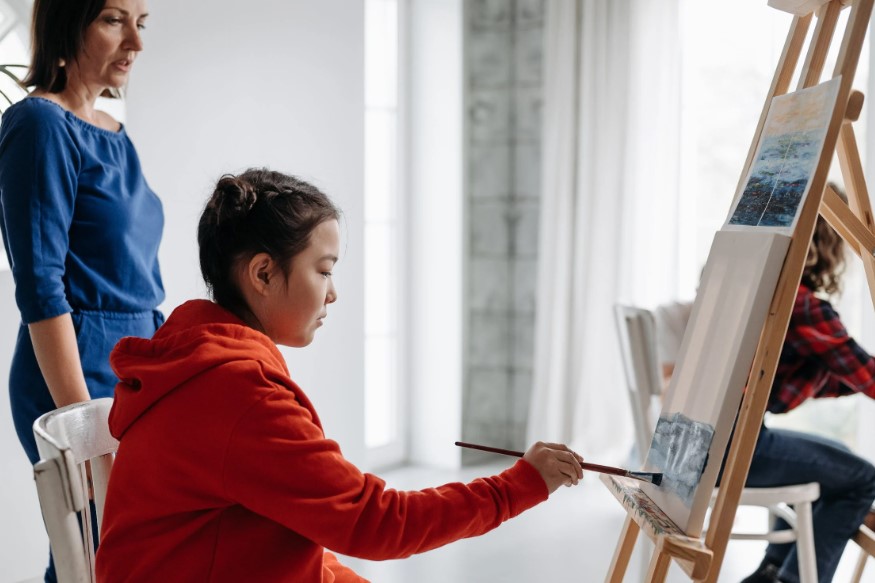Teaching drawing and painting can be highly satisfying and challenging in the meantime. To be a successful drawing and painting teacher, you should have immense patience and encouragement for your students. Furthermore, you also have to refrain from being highly judgmental of the students when making a mistake.
That is because your students have to start learning from somewhere. So you can consider introducing your students to sketching, then slowly going up the ladder to teaching complex techniques like shading. By doing so, you can instill confidence in your students. So your students will become more confident in developing artistic skills and ease the learning process.
In this article, we have come up with a few suggestions that may prove to be effective techniques for teaching drawing and painting.
1. Begin with line drawing
This technique only involves drawing lines and does not involve shading. That will help you explain to your students about the importance of the quality of lines. The lines vary in thickness and weight depending on the pressure applied to the pencil. To give your students a better understanding, you can show them as many examples as you want.
Meanwhile, you can show your students how to draw lines by applying pressure on the pencil. So it becomes easier for students to comprehend the technique, learn how to hold the pencil, and use weight to draw different lines. As a teacher, if you are confident that your students have learned the techniques, you move on to other effective methods for teaching drawing and painting.
2. Introduce your students to sketching
Once you have your students well-versed in drawing lines, you can then introduce your students to sketching. For your students, it is about different shapes like circles or squares. Your students may not have to draw the perfect sketch. But they will find the tasks easier to do as they know the technique to draw the line.
Furthermore, the students will find drawing an interesting activity instead of a tedious one. Painting a picture consumes significant time. If you push your students to start painting at this stage, they will be wary of the assigned task and are likely to drop out of your drawing and painting class. Instead, sketching will be an interesting task for your students.
That will lay the foundation for the skill they have to master and will prove to be one of the most effective approaches to teaching drawing and painting.
3. Showcase your expertise
You will wonder what displaying your artistic skills has to do with teaching drawing and painting. A demonstration of your skills will help you to attract more students. Technological advancements have given you many avenues to display your artistic skills- for instance, creating a website and social media platforms.
The parents of your potential students or anyone who wants to learn will most likely search online to know whether there are any teachers or coaching institutes nearby. If you create a website, the parents are more likely to stumble upon the website. To enhance the website’s ranking and discoverability, you have to SEO optimize the website.
You can exhibit your best work for potential students on the website and upload videos to share a few tips for beginners. You can also consider writing blogs to share your knowledge that will help you to establish yourself as an expert in your field. Furthermore, you can select one of the best pictures from your students.
To improve students signing up for the class, you can leverage the potential of Art class scheduling software like Picktime. The software has a personalized booking page or widget that you can implant into your website where they can sign up for the class depending on their skill level- for instance, beginner, intermediate, and advanced.
When you teach students, you will have to manage multiple sessions daily. The calendar feature of the software gives you a complete overview of the daily class schedule. That will assist you in organizing the day to handle various classes daily and decide when to take a break between the classes.
The software sends automated reminders over email and SMS to the students. So you do not have to follow up with the students whether or not they will attend the class. That will help you to enhance communication with your students and keep track of their attendance. If there is any change in the class schedule, you can utilize the reminder feature to inform the students of the change in the class schedule.
The software sends automated reminders over email and SMS to the students. So you do not have to follow up with the students whether or not they will attend the class. That will help you to enhance communication with your students and keep track of their attendance. If there is any change in the class schedule, you can utilize the reminder feature to inform the students of the change in the class schedule. Furthermore, the software also lets you create a secure student information database.
4. Tell your students to draw simple objects
One of the effective methods of teaching drawing and painting is to give your students objects that are easy to draw and paint. You can consider giving things like an apple, a coffee mug, a water bottle, or any object you can quickly find in your surroundings. However, you have to pay close attention to your students to understand how they begin to draw. That will help you to know whether they implement the techniques learned correctly. Otherwise, you can correct them while they draw and paint the picture.
For instance, if you notice your students using long strokes, you can correct them immediately and ask them to use short strokes.
5. Give your students feedback
After your students have completed the assigned tasks, you can give your feedback to your students. That will boost their confidence manifold. However, remember that you should not be highly critical. Instead, you can adopt a subtle approach to explaining the mistakes committed by the students. By doing so, the students will develop confidence in their skills and motivate them to strive to improve.
To sum up, effective techniques for teaching drawing and painting begin with small steps. For instance, you can start with line drawing, then sketching, and give your students easy objects to draw and paint. Finally, you have to focus on giving your students constructive feedback to improve their artistic skills.




